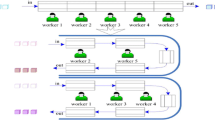Abstract
Seru, as a new effective and flexible production system, has been successfully proved in practice and received more and more attention from academic communities. However, line-seru conversion is an interesting but difficult problem because the product demand is uncertain and worker’s skill levels are different. In this paper, we propose a multi-objective model to describe line-seru problem with one product type but many orders for minimizing the total flow time and the total labor cost. Taking line-seru conversion problem in the electronics industries as an example, how much time and cost can be reduced and how many efficiencies can be improved by line-seru conversion are analyzed. According to the solutions of the proposed multi-objective model, seru has a great performance and different seru combinations can bring unequal reduction of time and cost.
Access this chapter
Tax calculation will be finalised at checkout
Purchases are for personal use only
Similar content being viewed by others
References
Estrada DC, Shukla A, Cochran DS (2000) Converting from moving assembly lines to cells. In: Proceedings of the third world congress on intelligent manufacturing processes and systems, MA, pp 28–30
Johnson DJ (2005) Converting assembly lines to assembly cells at sheet metal products: insights on performance improvements. Int Product Res 43(7):1483–1509
Kaku I, Murase Y, Yin Y (2008) A study on human-task-related performances in converting conveyor assembly line to cellular manufacturing. Eur J Ind Eng 2(1):17–34
Kaku I, Tang J et al (2011) A review: practice and theory in line-cell conversion. INTECH Open Access Publisher, Croatia
Liu C, Lian J et al (2010) Seru seisan-an innovation of the production management mode in Japan. Asian J Technol Innov 18(2):89–113
Liu C, Yang N et al (2013) Training and assignment of multi-skilled workers for implementing seru production systems. Int J Adv Manufact Technol 69(5–8):937–959
Mayumi A (2005) How to deal with reduced volumes. IE Rev 46:45–50 (in Japanese)
Ōno T (1988) Toyota production system: beyond large-scale production. Productivity Press
Stecke KE, Yin Y et al (2012) Seru: the organizational extension of jit for a super-talent factory. Int J Strateg Decis Sci (IJSDS) 3(1):106–119
Takeuchi H (2008) The contradictions that drive toyota’s success. Strateg Direction 25(1)
Yin Y, Kaku I et al (2006) Converting flow lines to manufacturing cells, another revolution, cellular manufacturing implementations in Japan. In: Proceedings of the third international conference on group technology/cellular manufacturing-GT/CM, pp 94–104
Yin Y, Kathryn E et al (2015) Integrating lean and agile production in a highly volatile environment with seru production systems: sony and canon case studies. J Oper Manag
Yu Y, Gong J et al (2012) How to carry out assembly line-cell conversion? a discussion based on factor analysis of system performance improvements. Int J Product Res 50(18):5259–5280
Yu Y, Tang J et al (2013) Reducing worker (s) by converting assembly line into a pure cell system. Int J Product Econ 145(2):799–806
Yu Y, Tang J et al (2014) Mathematical analysis and solutions for multi-objective line-cell conversion problem. Eur J Oper Res 236(2):774–786
Acknowledgments
This research was sponsored by Natural Science Foundation of China (NSFC Grant No. 71401075, 71472089), Jiangsu Provincial Natural Science Foundation of China (Grant No. BK20130753), and the Fundamental Research Funds for the Central Universities (Grant No. JGQN1403).
Author information
Authors and Affiliations
Corresponding author
Editor information
Editors and Affiliations
Rights and permissions
Copyright information
© 2017 Springer Science+Business Media Singapore
About this paper
Cite this paper
Shao, L., Zhang, Z., Yin, Y. (2017). Production System Performance Improvement by Assembly Line-seru Conversion. In: Xu, J., Hajiyev, A., Nickel, S., Gen, M. (eds) Proceedings of the Tenth International Conference on Management Science and Engineering Management. Advances in Intelligent Systems and Computing, vol 502. Springer, Singapore. https://doi.org/10.1007/978-981-10-1837-4_95
Download citation
DOI: https://doi.org/10.1007/978-981-10-1837-4_95
Published:
Publisher Name: Springer, Singapore
Print ISBN: 978-981-10-1836-7
Online ISBN: 978-981-10-1837-4
eBook Packages: EngineeringEngineering (R0)



